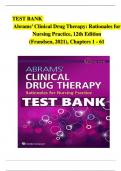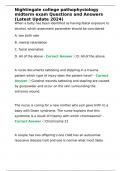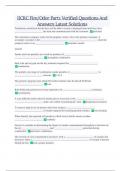TEST BANK
Abrams’ Clinical Drug Therapy: Rationales for
Nursing Practice, 12th Edition
(Frandsen, 2021), Chapters 1 - 61
,
,
,Chapter 1, The Foundation of Pharmacology: Quality and Safety
1. A woman diagnosed with obsessive–compulsive disorder has been prescribed oral
paroxetine hydrochloride. What is the expected effect for this prescription?
A. Curative effect on symptoms
B. Systemic effect on symptoms
C. Local effect on symptoms
D. Parenteral effect on symptoms
ANSWER: B
Rationale: Drugs that produce systemic effects are taken into the body, circulated through
the bloodstream to their sites of action in various body tissues, and eventually eliminated
from the body. Curative agents are given to cure a disease process. In this case, paroxetine
hydrochloride will control the symptoms but not cure the disorder. Drugs with local effects,
such as sunscreen and local anesthetics, act mainly at the site of application. Paroxetine
hydrochloride is not administered parenterally. Parenteral agents are administered
subcutaneously, intramuscularly, or intravenously.
PTS: 1 REF: p. 3, Introduction OBJ: 1
NAT: Client Needs: Physiological Integrity: Pharmacological and Parenteral Therapies
TOP: Chapter: 1: The Foundation of Pharmacology: Quality and Safety
KEY: Integrated Process: Nursing Process
BLM: Cognitive Level: Understand NOT: Multiple Choice
2. A client has been prescribed an antibiotic. This medication is a naturally occurring
substance that has been cheG
mRicA
alDlyEm
SoBdOifOieSd.TWhaOt M
.C is another name for this type of
medication?
A. Synthetic drug
B. Semisynthetic drug
C. Biotechnology drug
D. Prototype drug
ANSWER: B
Rationale: Semisynthetic drugs (e.g., many antibiotics) are naturally occurring substances
that have been chemically modified. Synthetic drugs are more standardized in their chemical
characteristics, more consistent in their effects, and less likely to produce allergic reactions.
Biotechnology drugs involve manipulating DNA and RNA and recombining genes into
hybrid molecules that can be inserted into living organisms. Prototype drugs are the first
drug of a particular group to be developed.
PTS: 1 REF: p. 3, Drug Sources OBJ: 1
NAT: Client Needs: Physiological Integrity: Pharmacological and Parenteral Therapies
TOP: Chapter: 1: The Foundation of Pharmacology: Quality and Safety
KEY: Integrated Process: Nursing Process
BLM: Cognitive Level: Understand NOT: Multiple Choice
3. Which classification applies to morphine?
A. Central nervous system depressant
B. Central nervous system stimulant
, C. Anti-inflammatory
D. Antihypertensive
ANSWER: A
Rationale: Drugs are classified according to their effects on particular body systems, their
therapeutic uses, and their chemical characteristics. Morphine is classified as a central
nervous system depressant and will produce this effect in the client. A central nervous
system stimulant increases attention and raises mood. An anti-inflammatory agent decreases
inflammation at the site of tissue or joint inflammation. An antihypertensive agent reduces
blood pressure.
PTS: 1 REF: p. 3, Drug Classifications and Prototypes
OBJ: 1
NAT: Client Needs: Physiological Integrity: Pharmacological and Parenteral Therapies
TOP: Chapter: 1: The Foundation of Pharmacology: Quality and Safety
KEY: Integrated Process: Nursing Process
BLM: Cognitive Level: Remember NOT: Multiple Choice
G R A D E S B O O S T . C O M
4. A client is administered amoxicillin. The generic name of this medication belongs to which
drug group?
A. Selective serotonin reuptake inhibitors
B. Diuretics
C. Penicillins
D. ACE inhibitors
ANSWER: C
Rationale: The generic name often indicates the drug group (e.g., drugs with generic names
GRADESBOOST.COM
ending in “cillin” are penicillins). Selective serotonin reuptake inhibitors are medications
that have antidepressant effects; SSRI is a broad classification, not a generic name. Diuretics
are medications that increase urine output; diuretic is a broad classification, not a generic
name. ACE inhibitor is the broad classification for the angiotensin receptor blockers, not the
generic name.
PTS: 1 REF: p. 3, Drug Names OBJ: 2
NAT: Client Needs: Physiological Integrity: Pharmacological and Parenteral Therapies
TOP: Chapter: 1: The Foundation of Pharmacology: Quality and Safety
KEY: Integrated Process: Nursing Process
BLM: Cognitive Level: Understand NOT: Multiple Choice
5. The administration of diphenhydramine is regulated by which U.S. government agency?
A. Public Health Service
B. Federal Trade Commission
C. Occupational Safety and Health Administration
D. Food and Drug Administration
, Rationale: The Food and Drug Administration approves drugs for over-the-counter
availability, including the transfer of drugs from prescription to OTC status, and may
require clinical trials to determine the safety and effectiveness of OTC use. The Public
Health Service is regulated by the state to maintain the health of individual citizens of the
state. The Federal Trade Commission regulates imports and exports throughout the nation.
The Occupational Safety and Health Administration regulates safety within the workplace.
PTS: 1 REF: p. 4, Prescription and Nonprescription Drugs
OBJ: 4
NAT: Client Needs: Physiological Integrity: Pharmacological and Parenteral Therapies
TOP: Chapter: 1: The Foundation of Pharmacology: Quality and Safety
KEY: Integrated Process: Nursing Process
BLM: Cognitive Level: Understand NOT: Multiple Choice
6. In the U.S., the administration of anabolic steroids is regulated by which law?
A. The Food, Drug, and Cosmetic Act of 1938
B. The Comprehensive Drug Abuse Prevention and Control Act
C. The Harrison Narcotic Act
G R A D E S B O O S T . C O M
D. The Sherley Amendment
ANSWER: B
Rationale: The Comprehensive Drug Abuse Prevention and Control Act regulates the
manufacture and distribution of narcotics, stimulants, depressants, hallucinogens, and
anabolic steroids. The Food, Drug, and Cosmetic Act of 1938 revised and broadened FDA
powers and responsibilities, giving the FDA control over drug safety. The Harrison Narcotic
Act restricted the importation, manufacture, sale, and use of opium, cocaine, marijuana, and
other drugs that the act defiG
neRdAaD
sEnaSrcBoO
tiO
csSTh.eCSOhM
.T erley Amendment of 1912 prohibited
fraudulent claims of drug effectiveness.
PTS: 1 REF: p. 4, Prescription and Nonprescription Drugs
OBJ: 3
NAT: Client Needs: Physiological Integrity: Pharmacological and Parenteral Therapies
TOP: Chapter: 1: The Foundation of Pharmacology: Quality and Safety
KEY: Integrated Process: Nursing Process
BLM: Cognitive Level: Remember NOT: Multiple Choice
7. A nurse is responsible for maintaining an accurate count and record of the controlled
substances on the nursing division. This nursing action is regulated by which U.S. law or
agency?
A. The Food, Drug, and Cosmetic Act of 1938
B. The Public Health Service
C. The Drug Enforcement Administration
D. The Sherley Amendment
ANSWER: C
GRADESBOOST.COM #1 TEST BANKS WEBSITE
, Rationale: The Drug Enforcement Administration enforces the Controlled Substances Act.
Under this enforcement, nurses are responsible for storing controlled substances in locked
containers, administering them only to the people for whom they are prescribed, recording
each dose given, and maintaining an accurate inventory. The Food, Drug, and Cosmetic Act
of 1938 revised and broadened FDA powers and responsibilities, giving the FDA control
over drug safety. The Public Health Service is regulated by the state to maintain the health
of individual citizens of the state. The Sherley Amendment of 1912 prohibited fraudulent
claims of drug effectiveness.
PTS: 1 REF: p. 7, Testing Procedure OBJ: 4
NAT: Client Needs: Physiological Integrity: Pharmacological and Parenteral Therapies
TOP: Chapter: 1: The Foundation of Pharmacology: Quality and Safety
KEY: Integrated Process: Nursing Process
BLM: Cognitive Level: Understand NOT: Multiple Choice
8. In Phase 1 clinical trials, the potential uses and effects of a new drug are determined by
which method?
A. Administering doses to healthy volunteers
G R A D E S B O O S T . C O M
B. Administering doses to people with the disease
C. Administering in placebo-controlled design
D. Calculating the risk-to-benefit ratio
ANSWER: A
Rationale: Phase 1 studies allow for the administration of the medication to healthy
volunteers to determine safe dosages, routes of administration, absorption, metabolism,
excretion, and toxicity. In Phase 2 studies, a few doses are given to a certain number of
subjects with the disease orGsR
ymApDtoEmSB
foOr O
wShiT
ch.tChO
eMdrug is being studied and responses are
compared with those of healthy subjects. Placebo-controlled designs are used in Phase 3
studies, in which half of the subjects receive the new drug and half receive the placebo.
Calculating the risk-to-benefit ratio is used in Phase 2 studies to determine whether the
potential benefits of the drug outweigh the risks.
PTS: 1 REF: p. 7, Testing Procedure OBJ: 5
NAT: Client Needs: Physiological Integrity: Pharmacological and Parenteral Therapies
TOP: Chapter: 1: The Foundation of Pharmacology: Quality and Safety
KEY: Integrated Process: Nursing Process
BLM: Cognitive Level: Understand NOT: Multiple Choice
9. A new medication for the treatment of Alzheimer’s disease is being administered to a group
of subjects with the disease. The subjects receiving this medication are unaware of whether
they are being administered the medication or a placebo. This testing occurs in which
phase?
A. Phase 1
B. Phase 2
C. Phase 3
D. Phase 4
ANSWER:
C
GRADESBOOST.COM #1 TEST BANKS WEBSITE
, GRADESBOOST.COM
Rationale: In Phase 3, the drug is given to a larger and more representative group of
subjects. In double-blind, placebo-controlled designs, half of the subjects receive the new
drug and half receive a placebo (an inactive substance similar in appearance to the actual
drug), with neither subjects nor researchers knowing which subjects receive which
formulation. In Phase 1, a few doses are given to a certain number of healthy volunteers to
determine safe dosages, routes of administration, absorption, metabolism, excretion, and
toxicity. In Phase 2, a few doses are given to a certain number of subjects with the disease or
symptom for which the drug is being studied and responses are compared with those of
healthy subjects. In Phase 4, the FDA evaluates the data from the first three phases for drug
safety and effectiveness, allows the drug to be marketed for general use, and requires
manufacturers to continue monitoring the drug’s effects.
PTS: 1 REF: p. 7, Testing Procedure OBJ: 5
NAT: Client Needs: Physiological Integrity: Pharmacological and Parenteral Therapies
TOP: Chapter: 1: The Foundation of Pharmacology: Quality and Safety
KEY: Integrated Process: Nursing Process
BLM: Cognitive Level: Understand NOT: Multiple Choice
G R A D E S B O O S T . C O M
10. Which organization is responsible for approving new drugs in the United States?
A. The American Medical Association (AMA)
B. The American Pharmaceutical Association (APA)
C. The Food and Drug Administration (FDA)
D. The U.S. Pharmacopeia
ANSWER: C
Rationale: The Food and Drug Administration is responsible for approving new drugs in the
United States. The AmericaGnRMAeDdiEcS
alBAOsO
soS
ciTat.ioCnOrM
epresents the health care providers of the
United States. The American Pharmaceutical Association represents the pharmacists of the
United States. The U.S. Pharmacopeia was adopted in 1906 and is issued every 5 years
under the supervision of a national committee of pharmacists, scientists, and health care
providers to provide information concerning drug purity and strength.
PTS: 1 REF: p. 7, Testing Procedure OBJ: 3
NAT: Client Needs: Safe and Effective Care Environment: Management of Care
TOP: Chapter: 1: The Foundation of Pharmacology: Quality and Safety
KEY: Integrated Process: Nursing Process
BLM: Cognitive Level: Remember NOT: Multiple Choice
11. A client with a long-standing dermatologic health problem has been advised to use a drug
with a local effect. The nurse should recognize what characteristic of this drug?
A. It affects only the organ system in which it is metabolized.
B. The drug requires application at multiple sites.
C. It is effective only as long as it is in contact with skin.
D. The drug acts primarily at the site where it is applied.
ANSWER: D
GRADESBOOST.COM #1 TEST BANKS WEBSITE
, GRADESBOOST.COM
Rationale: Drugs with local effects, such as sunscreen lotions and local anesthetics, act
mainly at the site of application. Those with systemic effects are taken into the body,
circulated through the bloodstream to their sites of action in various body tissues, and
eventually eliminated from the body. A drug with local effect does not necessarily have to
be applied at multiple sites, and its action may affect tissues long after contact.
PTS: 1 REF: p. 3, Introduction OBJ: 1
NAT: Client Needs: Physiological Integrity: Pharmacological and Parenteral Therapies
TOP: Chapter: 1: The Foundation of Pharmacology: Quality and Safety
KEY: Integrated Process: Nursing Process
BLM: Cognitive Level: Analyze NOT: Multiple Choice
12. What is the primary importance of a black box warning?
A. It will result in the medication being removed from the market.
B. It acknowledges that the medication has been tested on only a selected portion of
the population.
C. It suggests that the prescription of the medication be avoided when treating certain
populations.
G R A D E S B O O S T . C O M
D. It alerts health care professionals of the potential of serious adverse effects
associated with the medication.
ANSWER: D
Rationale: Black box warnings identify the fact that a drug can cause serious adverse effects.
Subsequent withdrawal of approved and marketed drugs has occurred, usually because of
serious adverse effects that become evident only when the drugs are used in a large, diverse
population. The warning does not address testing or target populations.
GRADESBOOST.COM
PTS: 1 REF: p. 7, Testing Procedure OBJ: 4
NAT: Client Needs: Physiological Integrity: Pharmacological and Parenteral Therapies
TOP: Chapter: 1: The Foundation of Pharmacology: Quality and Safety
KEY: Integrated Process: Nursing Process
BLM: Cognitive Level: Analyze NOT: Multiple Choice
13. A health care facility is complying with the mandates of U.S. The Drug Enforcement
Administration (DEA) concerning Schedule II medications when implementing which
nursing intervention? Select all that apply.
A. Access to narcotics is controlled by key or codes.
B. Narcotics are administered by prescriptions only.
C. Only selected narcotics may be automatically renewed.
D. The administration of individual narcotic doses is recorded in specific unit
documentation.
E. Any recognized discrepancy involving a narcotic must be reported to the
appropriate facility authority.
ANSWER: A, B, D, E
Rationale: Nurses are responsible for storing controlled substances in locked containers,
administering them only to the people for whom they are prescribed, recording each dose
given on agency narcotic sheets and on the client’s medication administration record,
maintaining an accurate inventory, and reporting discrepancies to the proper authorities.
Prescriptions for Schedule II drugs cannot be refilled; a new prescription is required.
GRADESBOOST.COM #1 TEST BANKS WEBSITE






